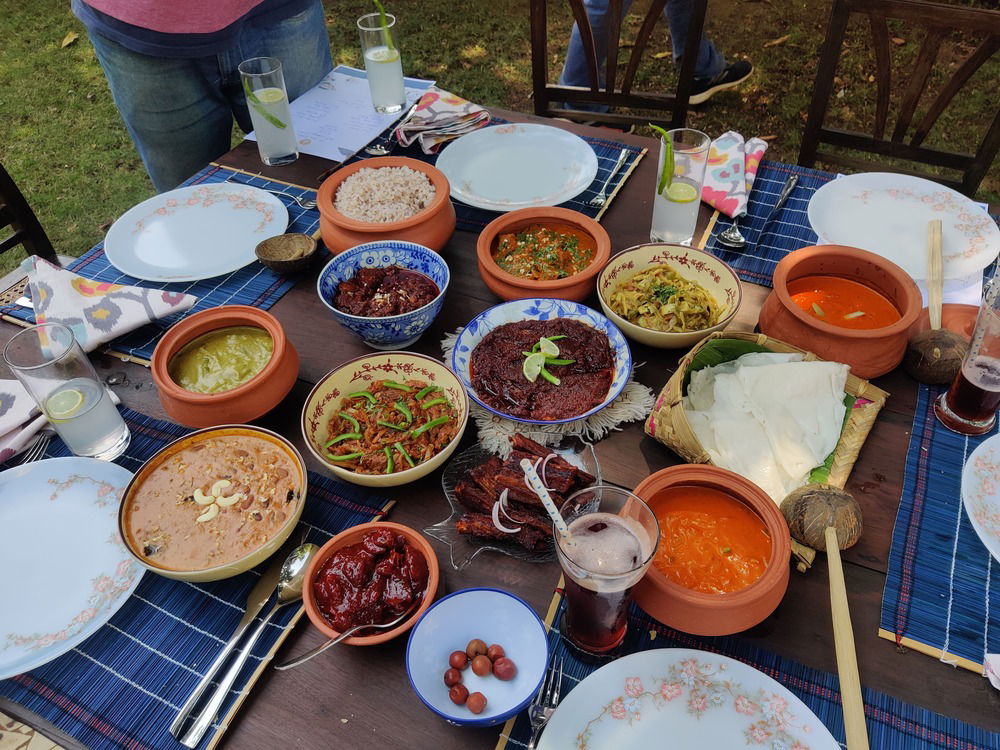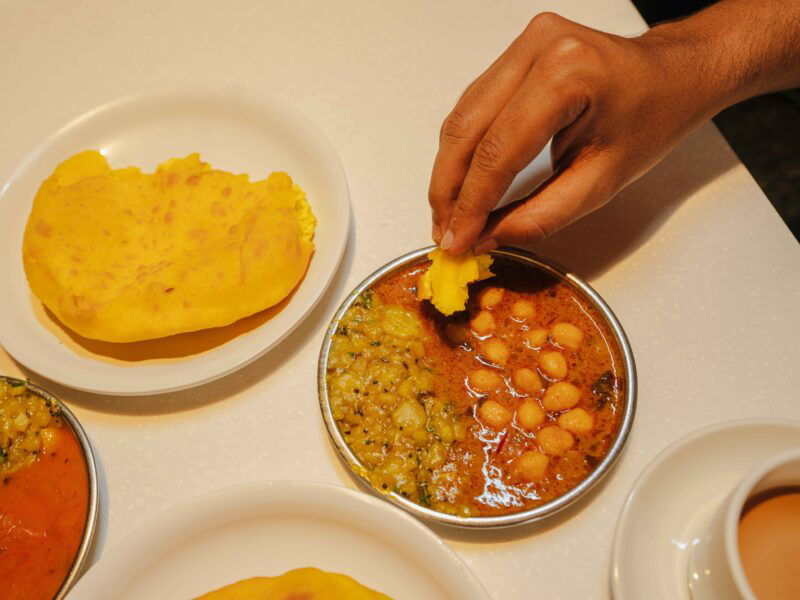Admit it, Goan cuisine is comfort food in itself, hitting all the right notes, while simultaneously bringing all the essential nutrition to the table! No matter what you pick, Goan food makes for a very wholesome meal that deserves an afternoon siesta. Yet today, Goan food is mainly defined by seafood fried a hundred different ways. But guess what? It doesn’t end there!
Don’t get us wrong, the curries represent a unique aspect i.e. the Saraswat Brahmin Hindu influence and the Portuguese Catholic influence on the cuisine of Goa. They would be the first thing we’d recommend too!
Here are some Goan dishes you should try for an offbeat Goa experience:
Vegetarian Goan Dishes:
- Khatkhatem
- Saansav
Non-vegetarian Goan curries
- Caldinha
- Feijoada
- Ambot Tik
- Uddamethi
- Sorpotel
Khatkhatem
A vegetable-loaded dish that is synonymous with the much loved festival of Ganesh Chaturthi in Goa, the Khatkhatem is as blissful as food can get! It is a crucial delicacy of the Saraswat Brahmins of Goa.
According to Sneha, a Goan Food Blogger, “Khatkhate is basically a spiced vegetable stew.” The base of the curry is made from grated coconut, lentils, and a whole lot of vegetables ranging from corn, brinjals, cucumbers, pumpkin and everything else that you can think of! For most Goan recipes, a touch of jaggery is what brings it all together.
2. Caldinha
Caldinha/ Caldin/ Caldeen is a preparation similar to the Khatkhatem, but was once a dish consumed only by the more elite class. The sole reason for this was the exorbitant price of coconuts in the days bygone. Funnily enough, this didn’t hinder Goans from adding coconut to most of their curries and other culinary preparations such as deserts and liquor.
This wonderful fusion of Portuguese and Konkan cuisine derives its name from the Portuguese word for soup, “caldo”. It has a very rich, creamy texture that comes from preparing ground coconut with flavourful spices like cumin and turmeric. The base is made using coconut milk which is obtained after this coconut paste is strained.
According to the owner of Viva Panjim, Linda D’Souza, an entire coconut goes into preparing one serving of caldinha. This curry can be made with either fish or vegetables, or both. A prawn and cauliflower caldinho is just as popular as an okra, mushroom or pumpkin caldinho.It is light on the spices, just delightfully creamy and is best enjoyed with Goan Pao or rice.
3. Feijoada
According to most, feijoada comes from Brazil. A part of the name itself – “feijao” – translates to “beans”, from Portuguese. One can even say that this dish stands out as some sort of a mascot for Portugal, finding it’s modifications throughout all Portuguese colonies, from Brazil to Goa to Angola and so on. While the Brazilian recipe mainly thrives on pork cuts and black beans, its Goan counterpart languishes in rajma (kidney beans) and choriz (Goan pork sausages).
The dish is best had with, of course, pao or poie until your bowl is wiped clean. If any remains, don’t forget, most Goan Curries age well and taste better with every passing day that they sit in your refrigerator.
4. Ambot Tik
On the other end of the curries spectrum, lies the Ambot Tik or the Ambotik. It lacks coconut, which was considered relatively expensive and hence, was known as the poor man’s curry. It’s a tangy, spicy preparation that comes as a celebration of flavours in your mouth. You’ll thoroughly enjoy the experience of eating Ambotik which is best served with hot rice.
Ambot is the Konkani word for sour and Tik refers to spicy (in Portuguese). It is usually prepared with calamari, sharks or sardines but you can make it with whatever fish fancies you. Its major flavours come from palm vinegar and tamarind, but some chefs go a step ahead and even use raw mangoes! The spiciness comes from the use of red chillies that are available in plenitude and in innumerable varieties in Goa.
5. Uddamethi
Uddamethi is an element of the Saraswat Brahmin Cuisine, belonging proudly to a community of Goan Brahmins that consume all local produce, including fish meat.
The name derives from an amalgamation of two Konkani/ marathi words – urad i.e. black gram, and methi i.e. Fenugreek. So uddamethi is a Goan fish curry that is made using black gram and Fenugreek seeds and hence, has a very flavorful bitter undertone to it. Along with this, coconut, peppercorns, jaggery, raw mangoes and ambade (hog plum), help create a smooth, sweet and spicy base for the curry. A substitute for the latter two ingredients would be tamarind which adds a similar tanginess.
Popular especially during summers when raw mangoes make their appearance in Goa, the uddamethi tastes best with rice and when prepared with mackerels or bimbli (tendli/ ivy gourd) for a vegetarian version. A traditional preparation would be done in an earthen pot.
6. Sorpotel
Sorpotel is a Goan preparation that came all the way from Lisbon with the Portuguese sailors. Initially it was made from all and any available parts of a pig and preserved using vinegar to last on the long naval voyages.
The name itself means a mix or mismash, and that is what sorpotel is. Best enjoyed with sannas, popular steamed rice bread, and Feni the key ingredient for a good sorpotel is toddy vinegar along with Kashmiri chillies, goan chillies and a variety of other spices. The toddy vinegar is made from the coconut palm today that takes almost a fortnight to collect and then ferment into vinegar.
Then the curry is prepared with its trademark sourness and refrigerated to be consumed for weeks. The sorpotel can be kept in an earthen kunddlem (an earthen pot used for cooking) for a few days to ripen it, further enhancing its flavour.
7. Saansav
Saasav is every Goan’s summer favourite and is usually prepared with mangoes or pineapples. The more popular version is the ghotache saasav which is a preparation made from baby mangoes during the summer season. These baby mangoes are known as ghota in the Konkani language. Saasav, from Konkani translates to mustard seeds which are used as a base for this curry.
The main ingredients that add to the flavour of this sweet and tangy curry are coconut, jaggery, chillies and mustard seeds. The mangoes are then squeezed after which the pulp and the seeds are both added to the curry.
Hot rice or puris complement this curry very well.
Goan cuisine has the kind of warmth that’d make any gloomy day better. There is so much more to the Goan Cuisine that one can enjoy.
The best experience one could get is dining in a Goan home hosted by a local family, driving diverse items – the Catholic elements, the Hindu elements, and even the tribal elements that are hidden away in the forests of Goa.
Do try the vindaloo, the Cafreal, the balchao and the Xacuti. But don’t forget that there’s so much more that defines Goa than just these beauties.
Happy eating!



